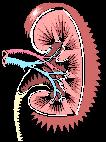Recommended Products
 The urinary system filters the blood and removes waste chemicals and excess water from the body. The kidneys, ureters, bladder and urethra make up the urinary system.
The urinary system filters the blood and removes waste chemicals and excess water from the body. The kidneys, ureters, bladder and urethra make up the urinary system.
A host of problems and disorders can affect this system. These include kidney stones, diabetes mellitus, hypertension, kidney cysts and tumors, infections, water retention, incontinence and back pain.
EXAMINING THE URINARY SYSTEM
Humans have two kidneys, each about 4 inches long and about 6 ounces in weight. They lie in the abdomen, one underneath the liver and the other underneath the spleen. The kidneys filter the blood and excrete waste products and excess water in the form of urine.
Inside the kidneys, the renal arteries divide into smaller and smaller branches until they become capillaries in the glomeruli, the kidney’s primary filtering units. Each kidney contains about one million glomeruli, which pass the filtered blood through long tubules. The glomeruli and the tubules make up the nephrons, the functioning units of the kidneys. The efficiency of the kidneys diminishes with age as the number of functional nephrons decreases.
The kidneys have many functions and responsibilities. In addition to filtering the blood, they regulate water and electrolyte levels, eliminate waste products and control the body’s acid-base balance. When excess water is ingested, the kidneys excrete it. When water is lost (as a result of diarrhea or sweating), the kidneys conserve it. The digestion of proteins generate ammonia, a powerful toxin that the kidneys eliminate from the body in the urine. When blood and body fluids become too acidic or too alkaline, the kidneys alter the urine acidity to restore balance.
The kidneys also produce or release several hormones. These include erythropoietin (stimulates the production of red blood cells), renin (increases the reabsorption of sodium), angiotensin (stimulates aldosterone production and increases sodium reabsorption) and aldosterone (affects salt and water balance).
Urine travels from the kidneys through ureters (tubes) and into the bladder. Outflow is controlled by valves that prevent urine from flowing back up the ureters.
The bladder serves as a temporary storage tank for urine. It has flexible walls, allowing it to expand as it fills. As the bladder reaches capacity the person senses the need to urinate. When the bladder empties, its walls contract, forcing the urine out.
The urethra is a single tube that carries urine from the bladder out of the body through the genitals. The urethra in males is about 10 inches long, while in females it is only about an inch long. Consequently women are much more susceptible to urinary tract infections than men.
Did You Know?
• The herb hydrangea was used by the Cherokee Indians as a remedy for kidney stones. Its diuretic, emetic and tonic properties make it an excellent choice for urinary concerns of all kinds.
• Gallup International found that 1 million Latin American people in the U.S. suffer fro a hyper active bladder, and at least one-third of them are searching for help. Hyperactive bladder is one of the principal causes of incontinence.
• A randomized, double-blind, placebo-controlled trial among elderly women found that dietary cranberry provides almost twice the reduction in urinary bacteria as a placebo.